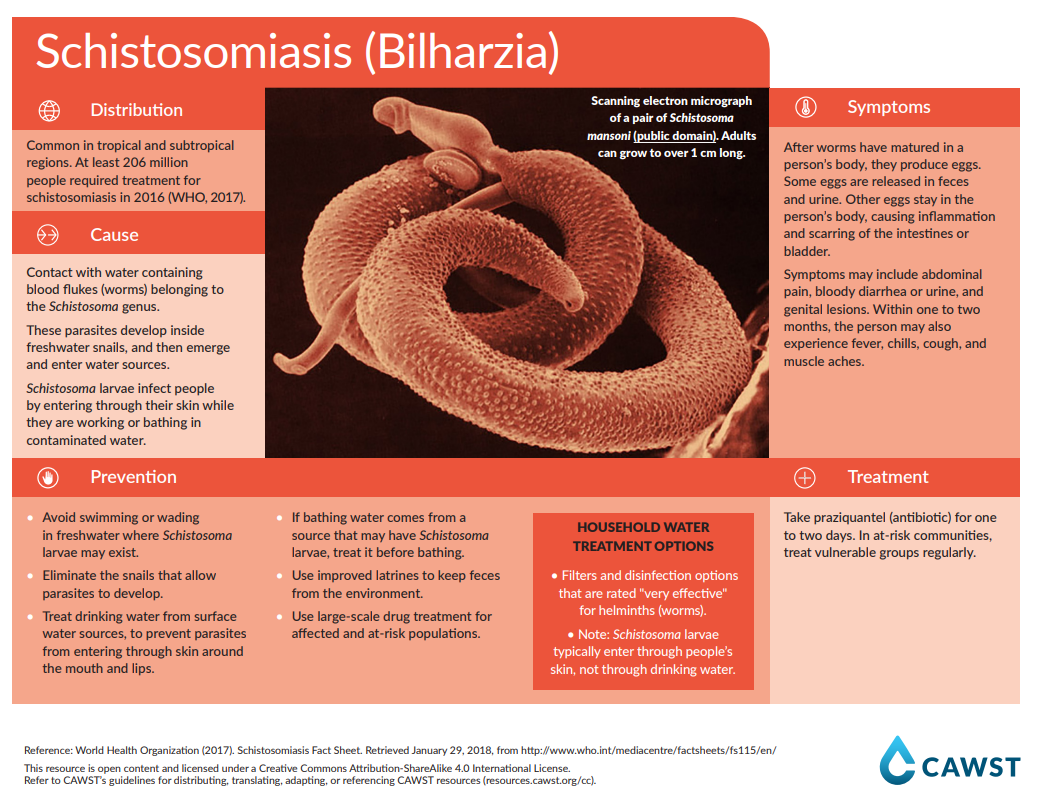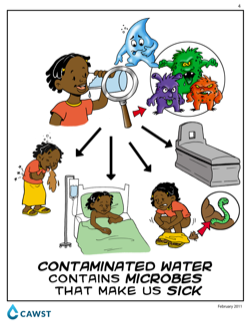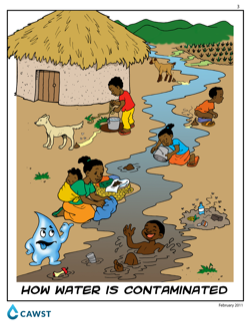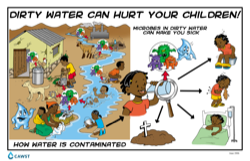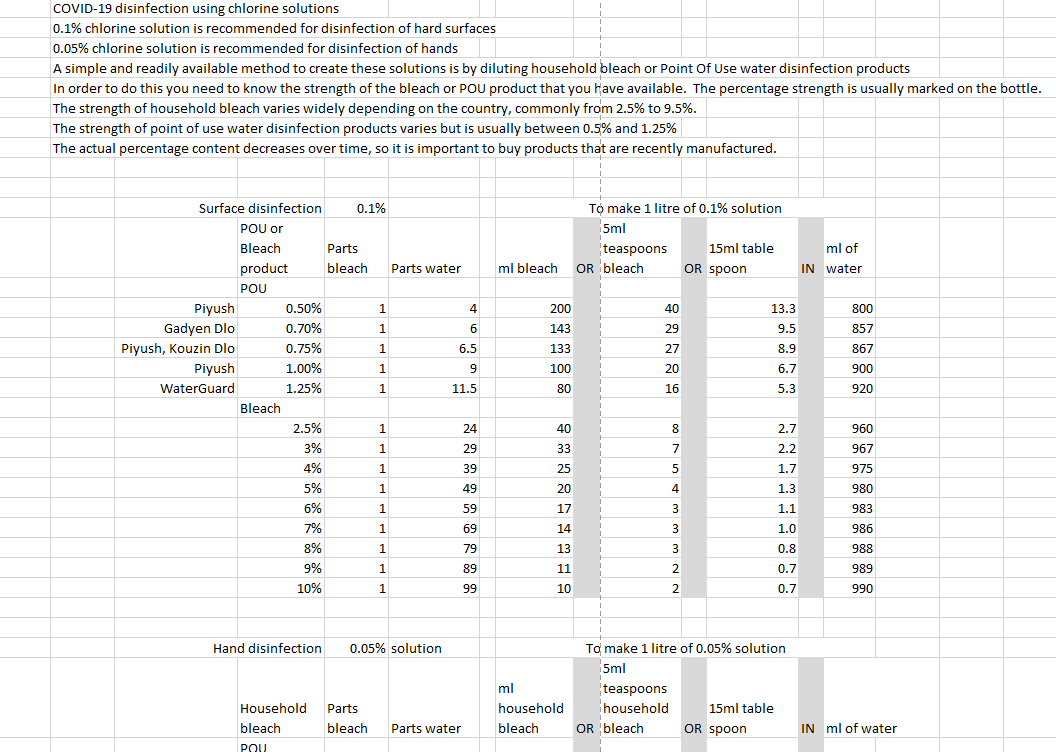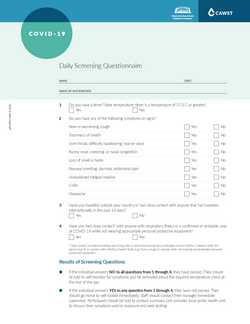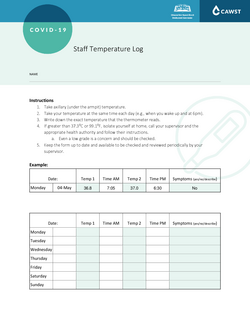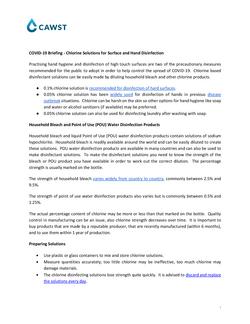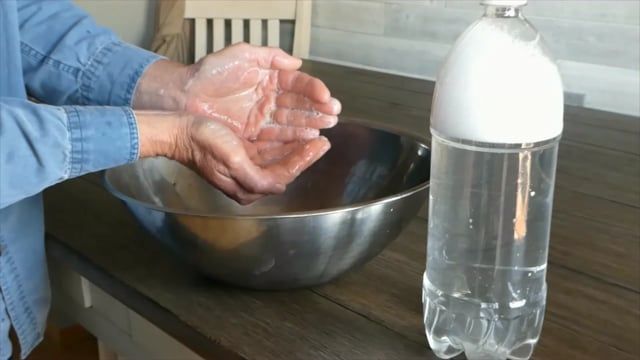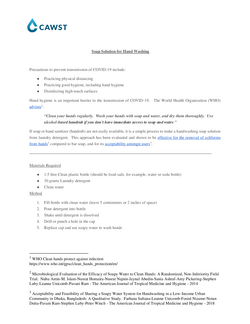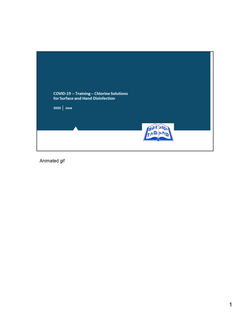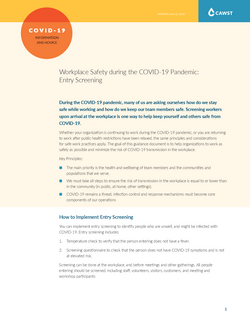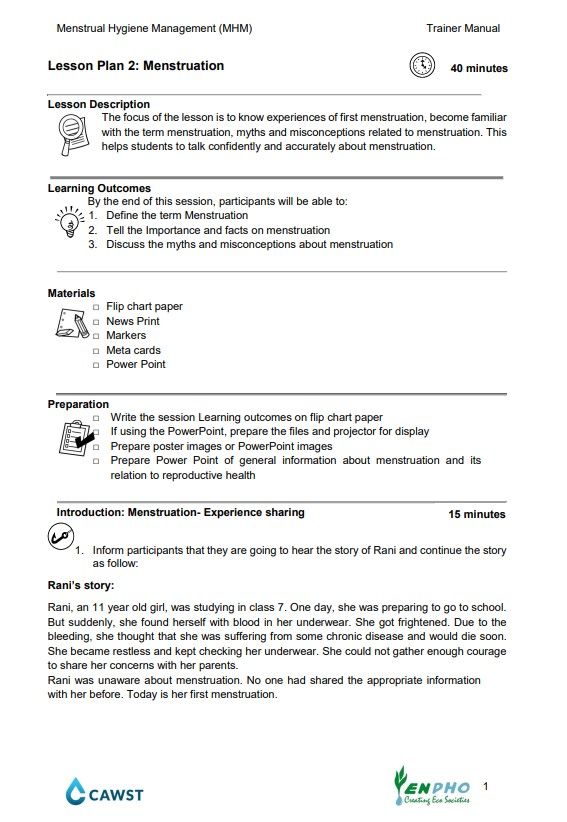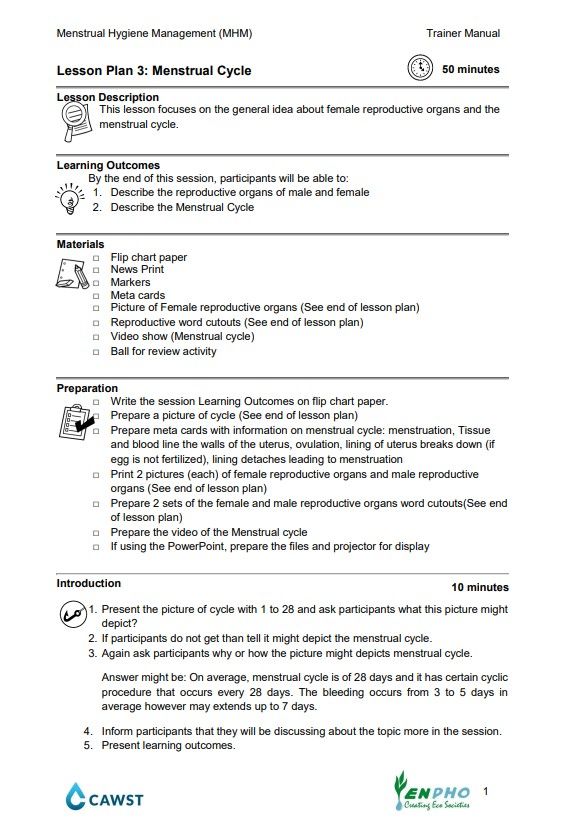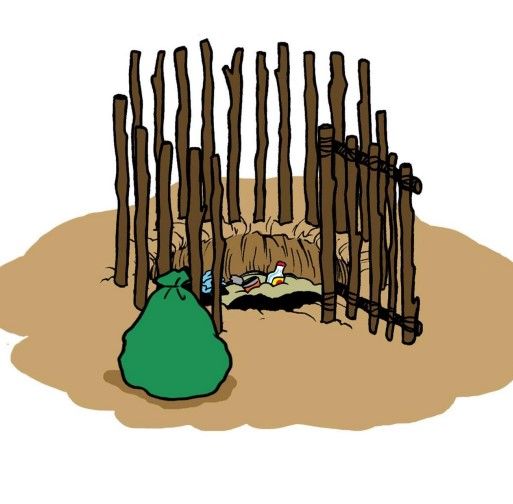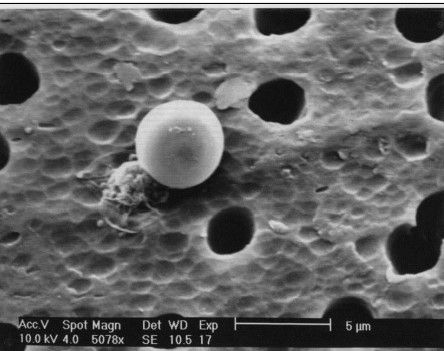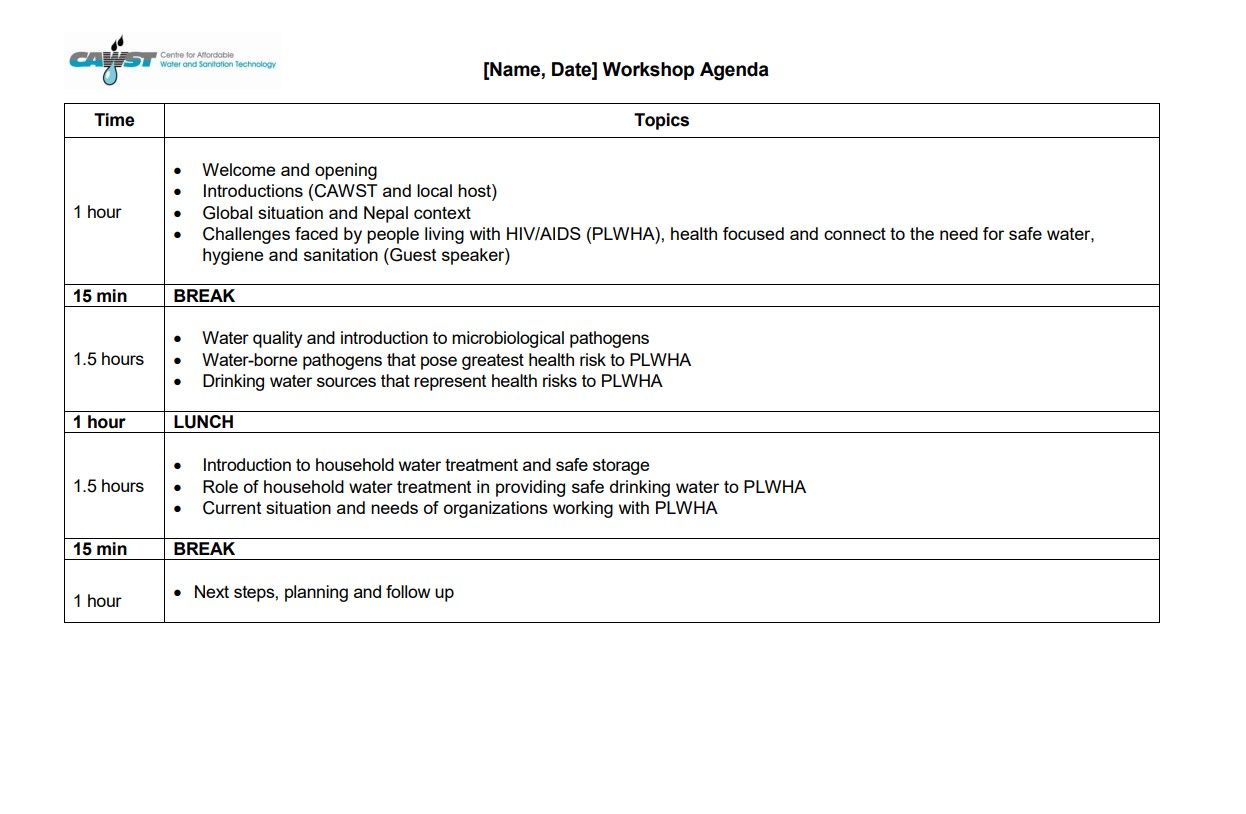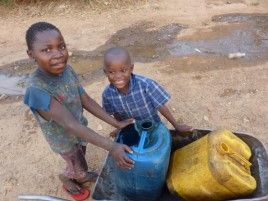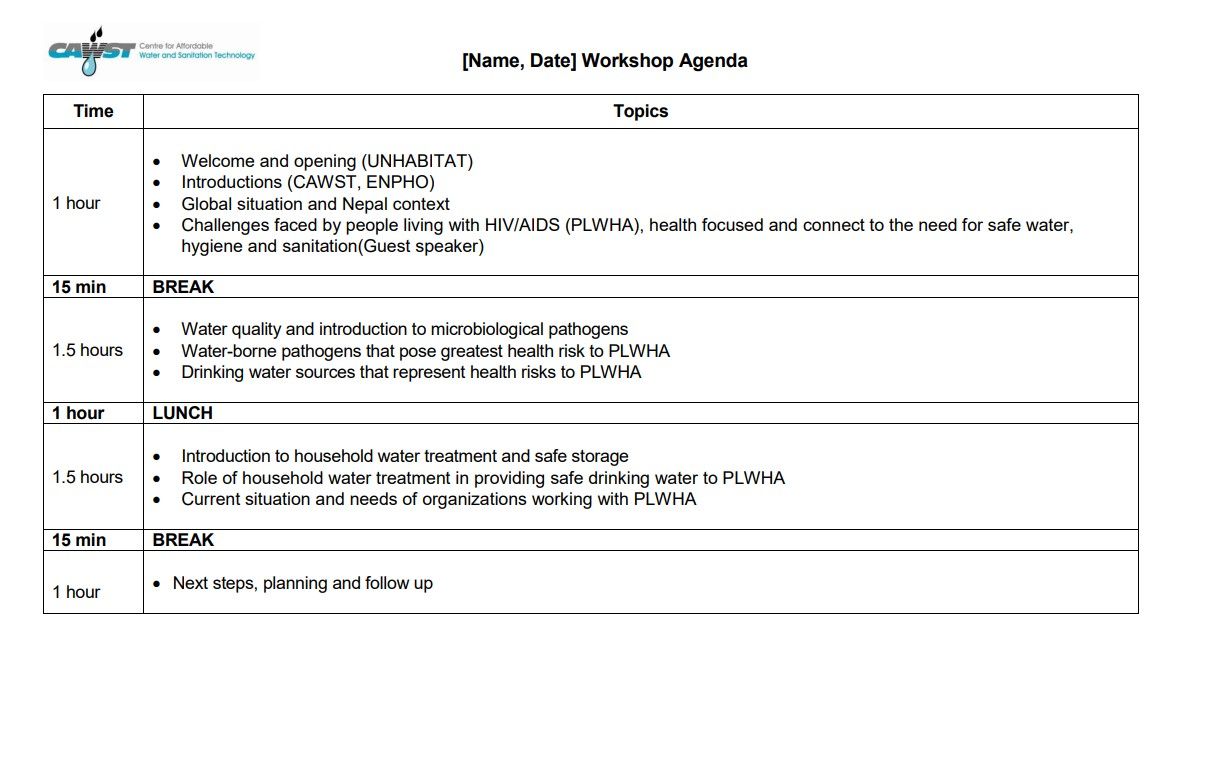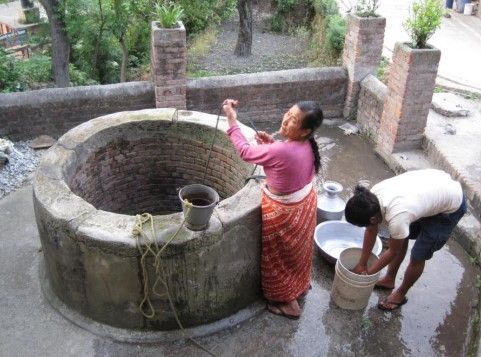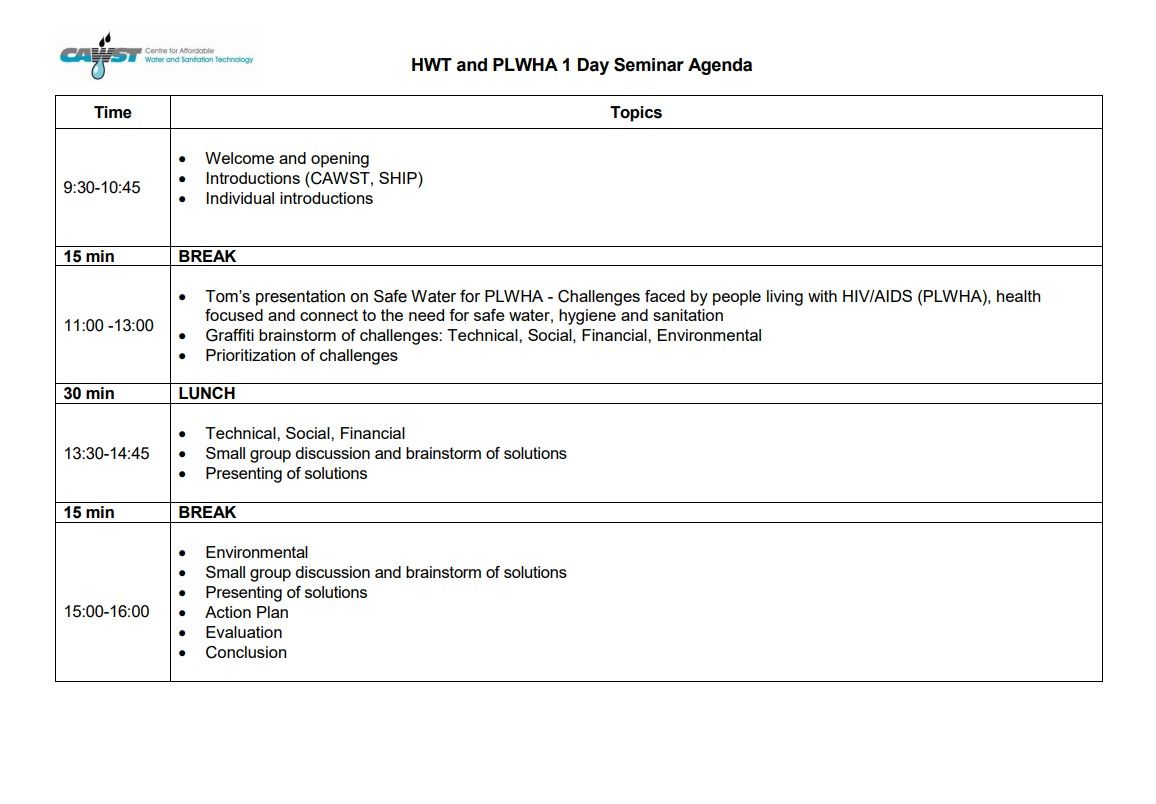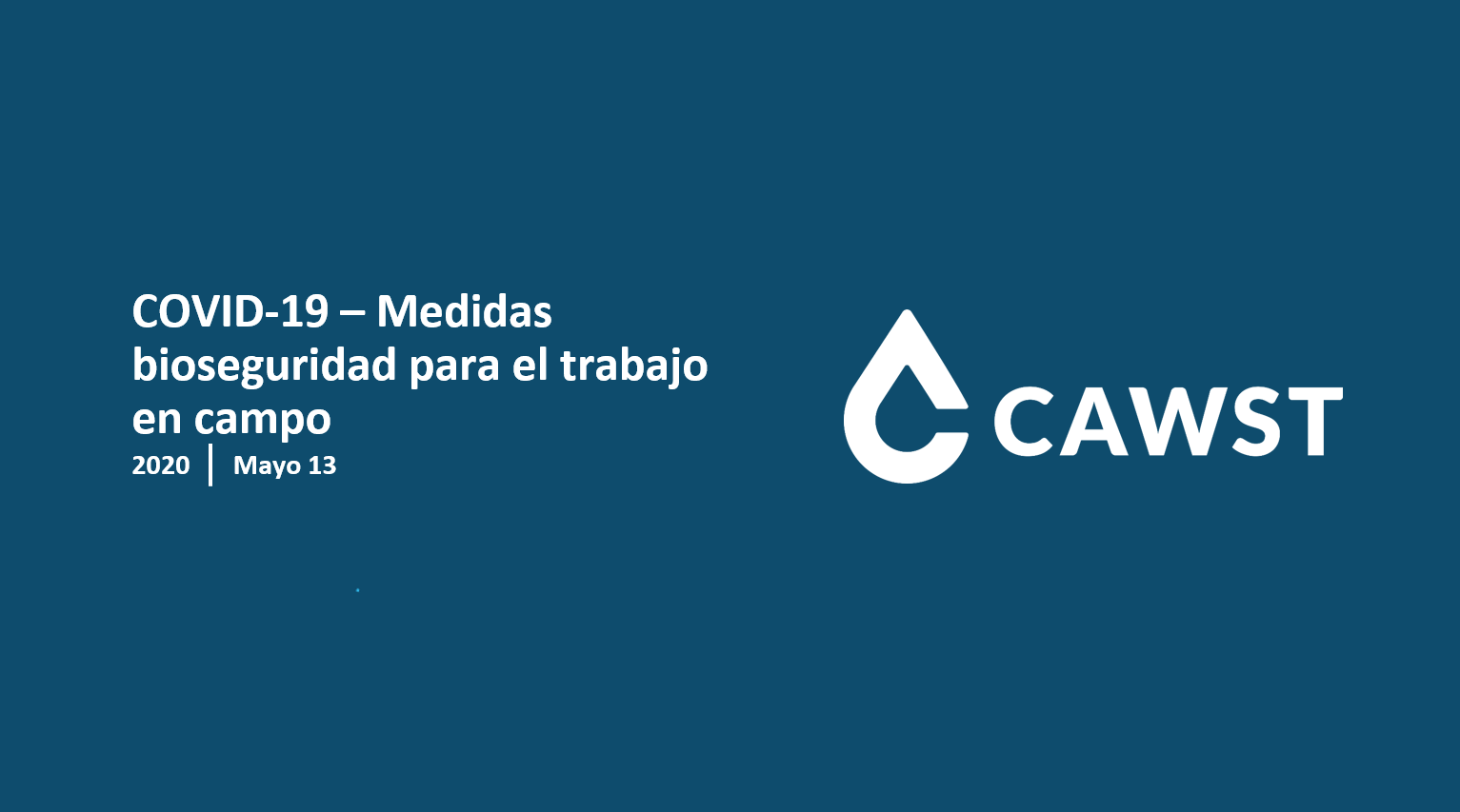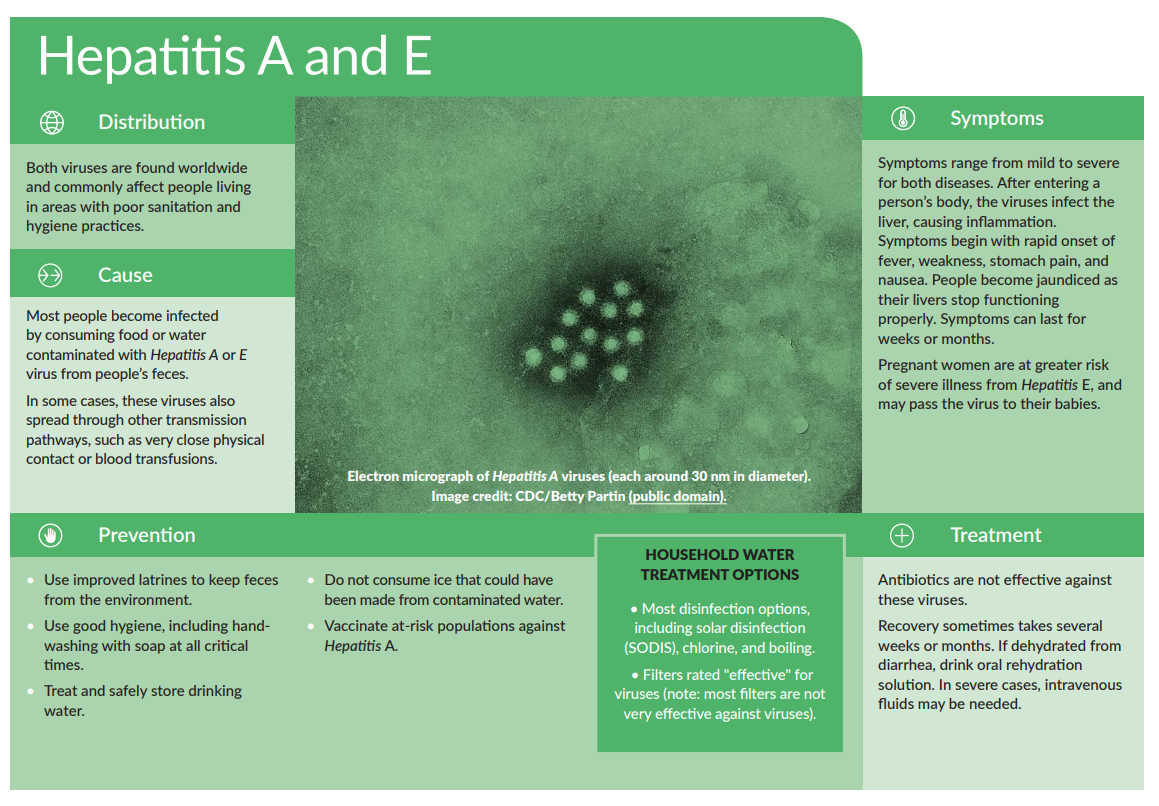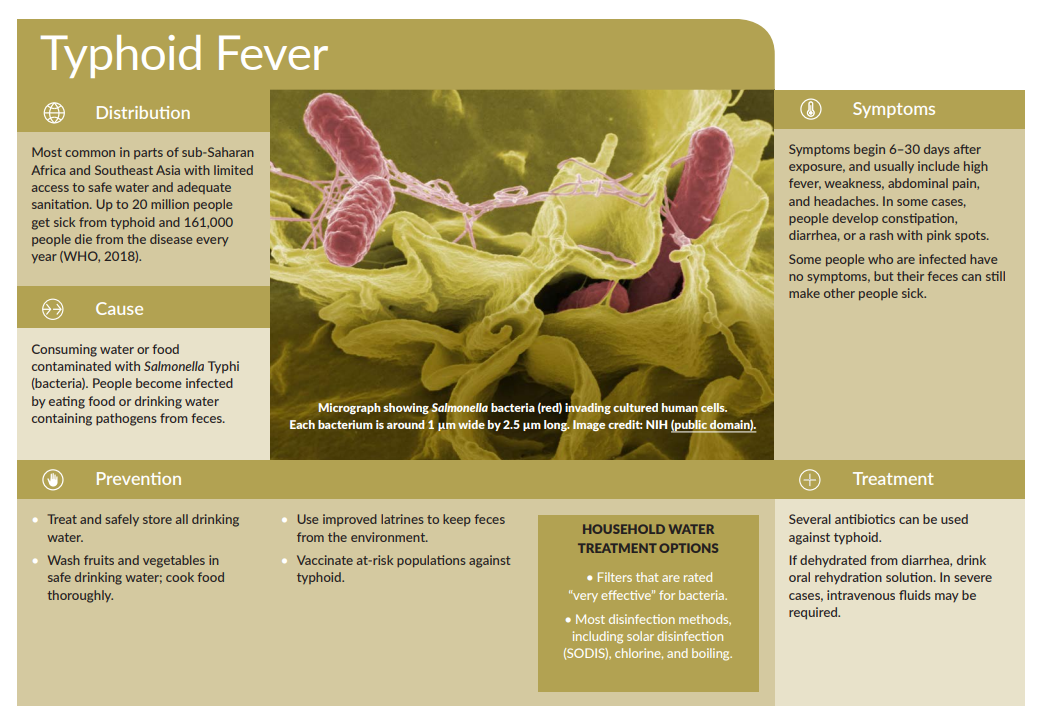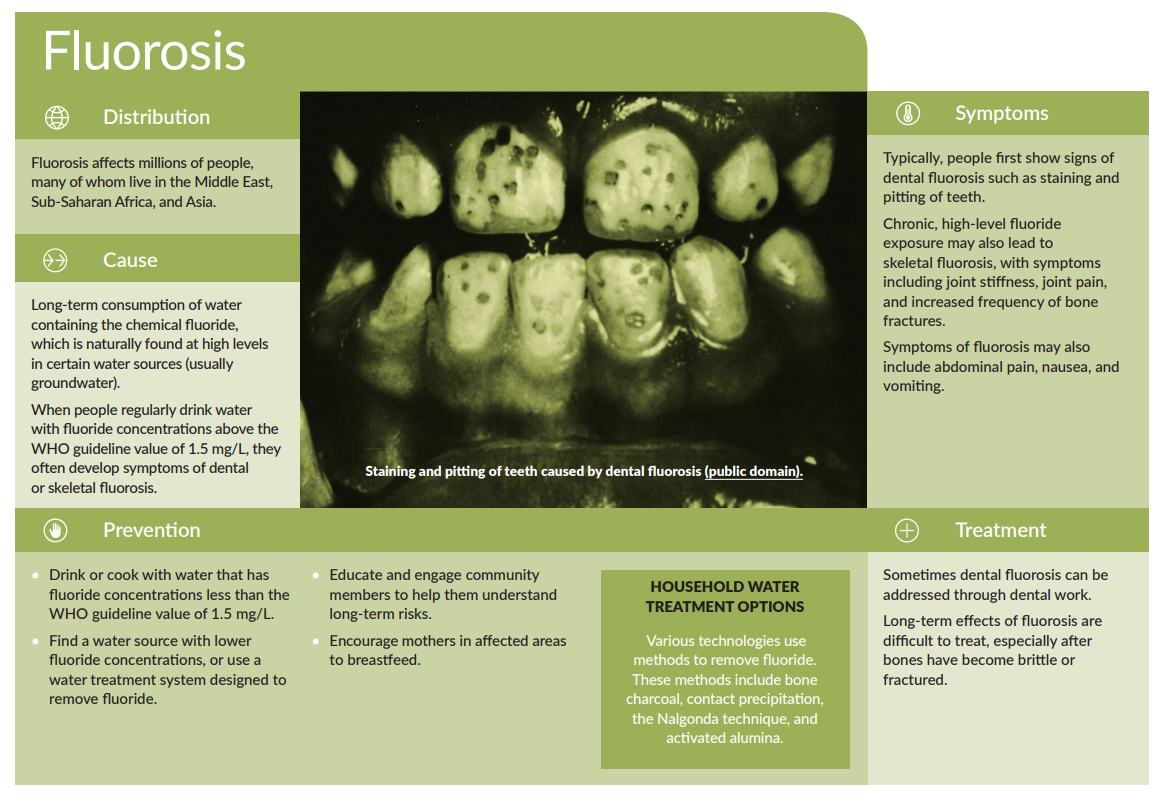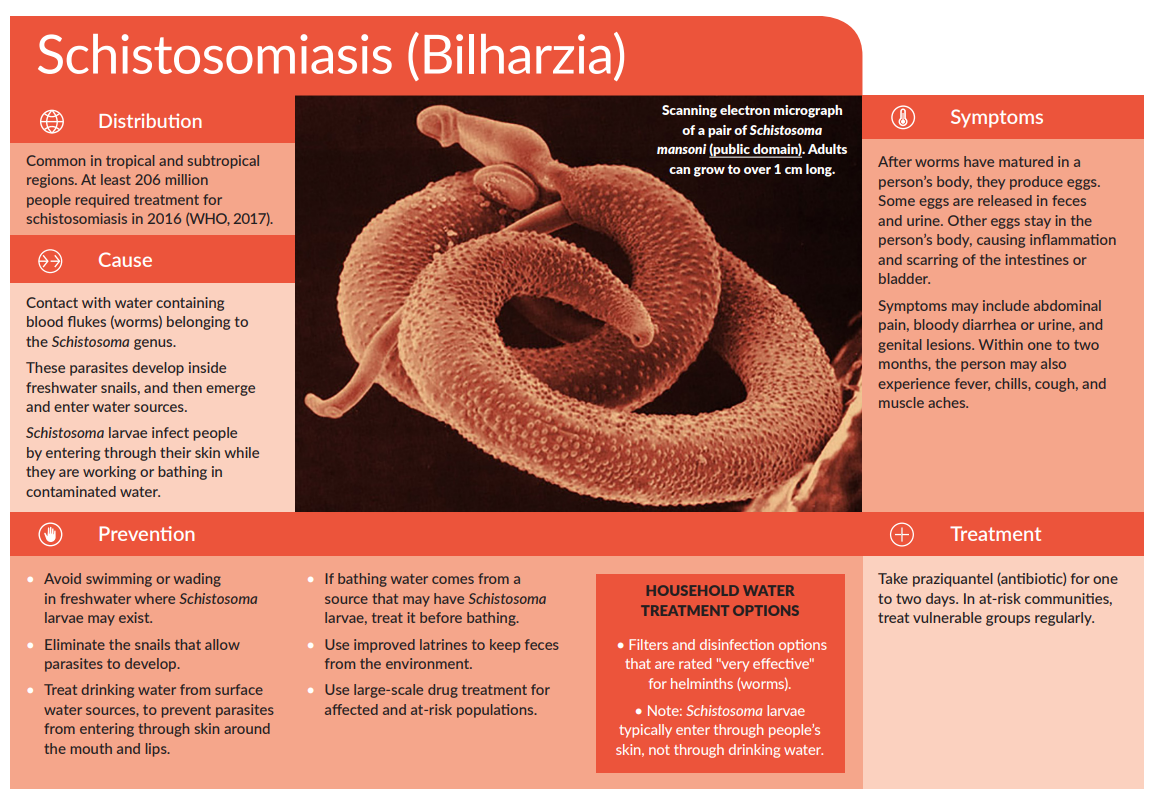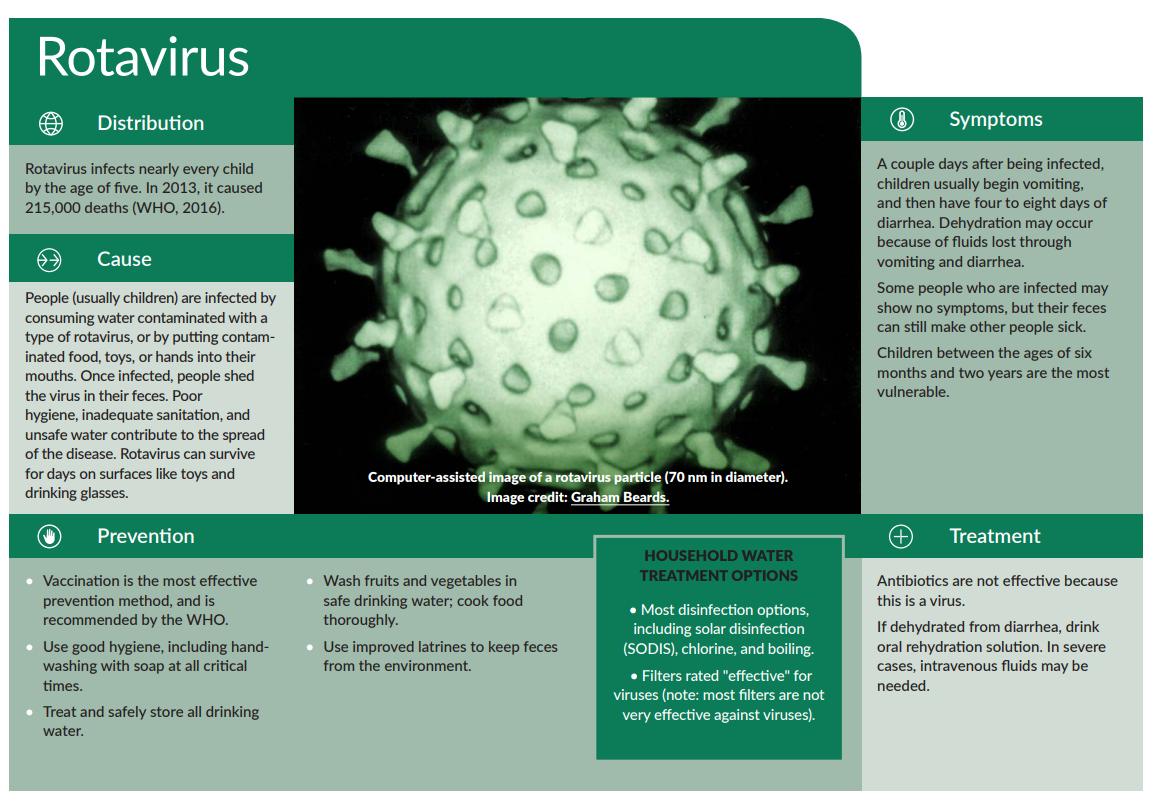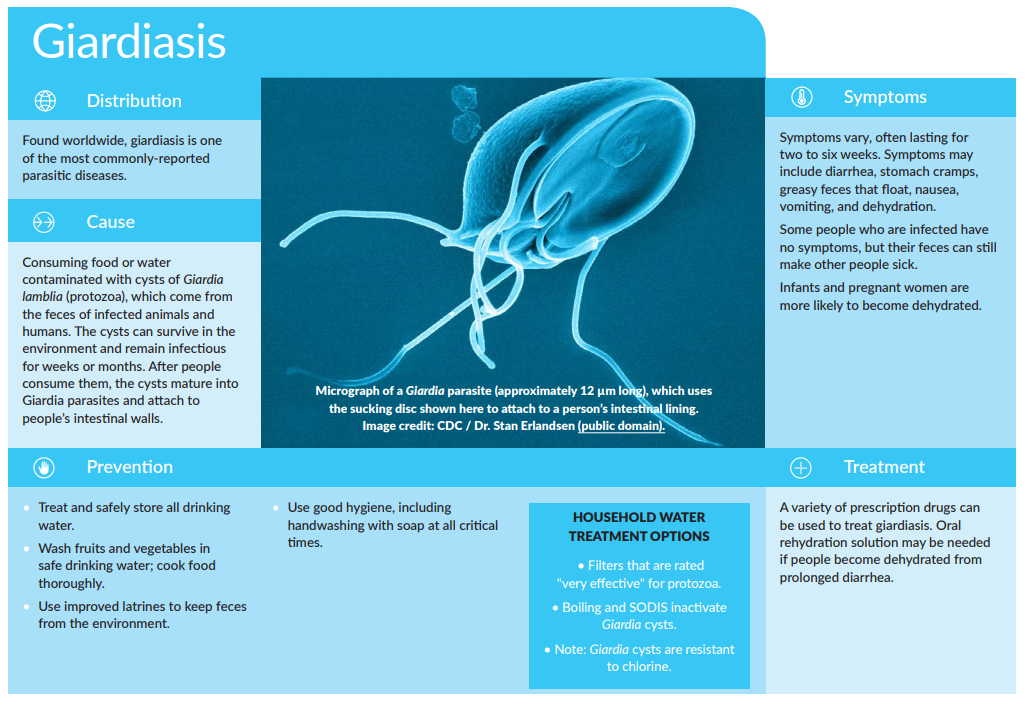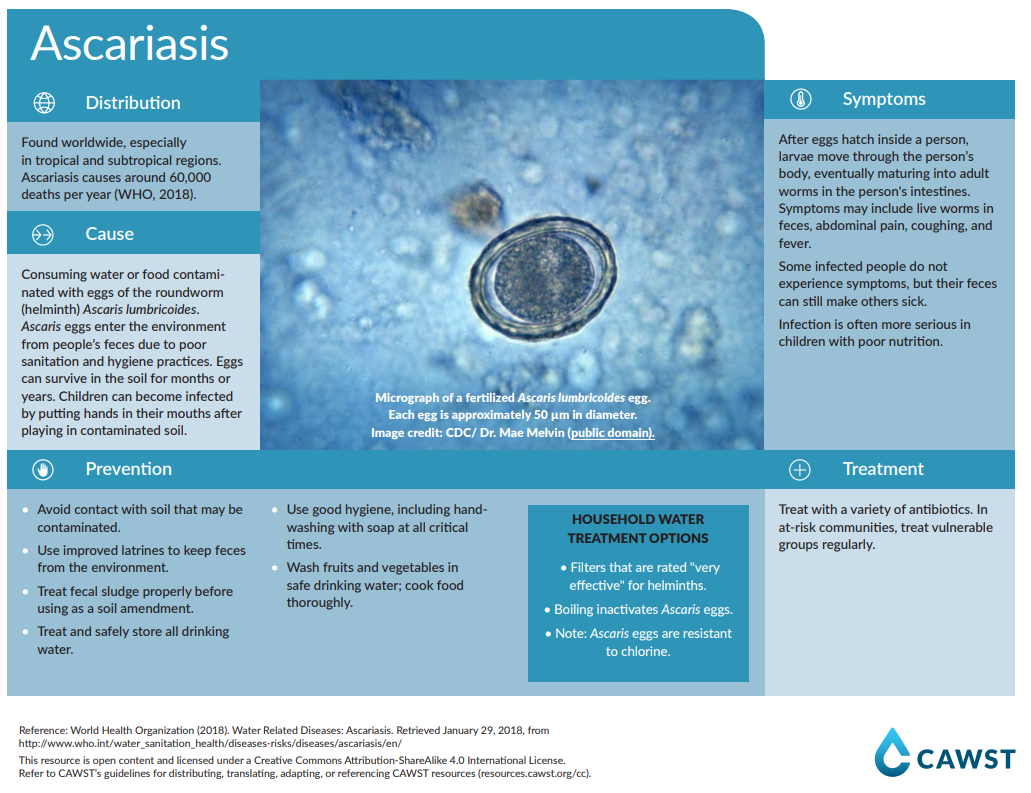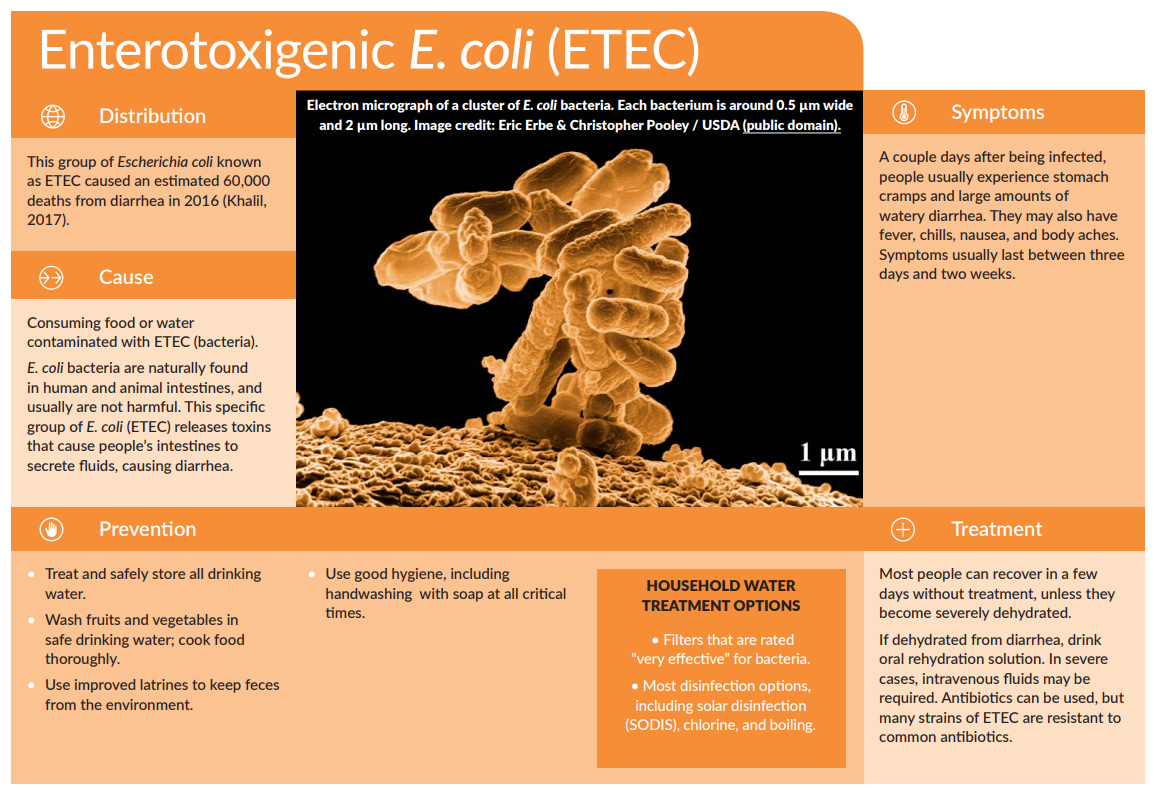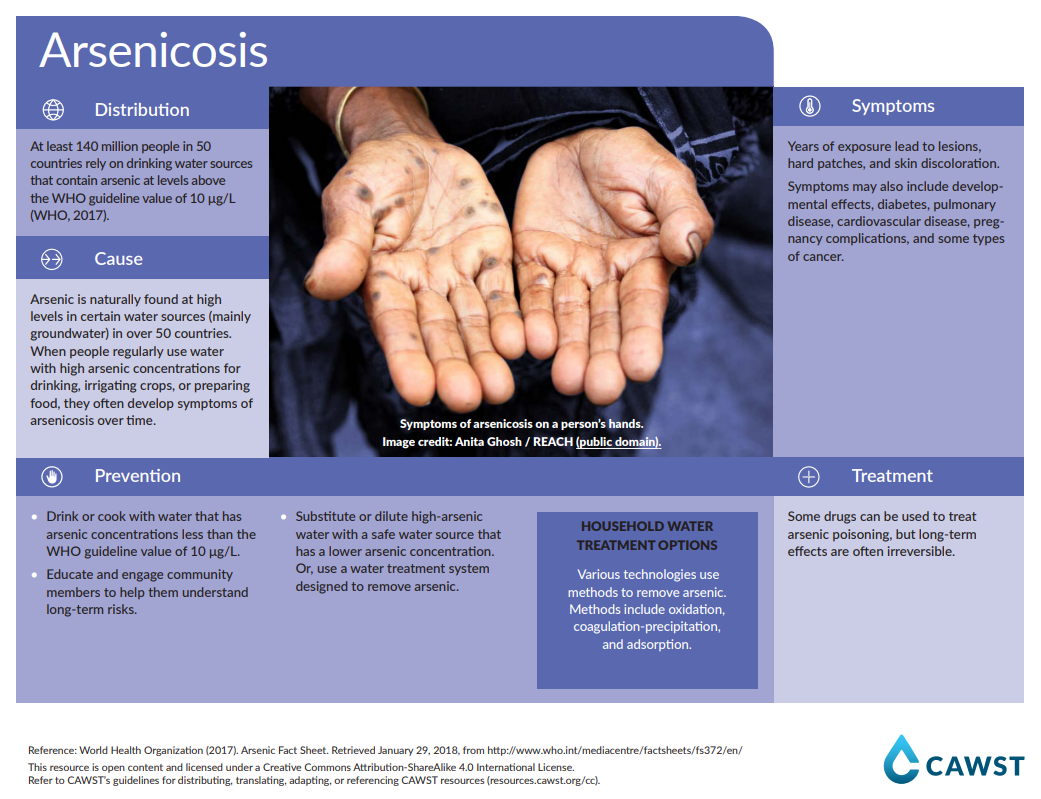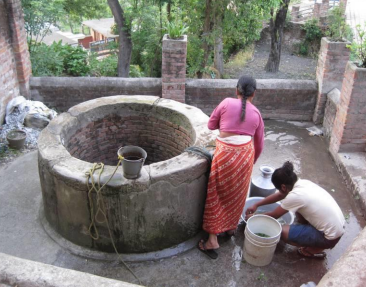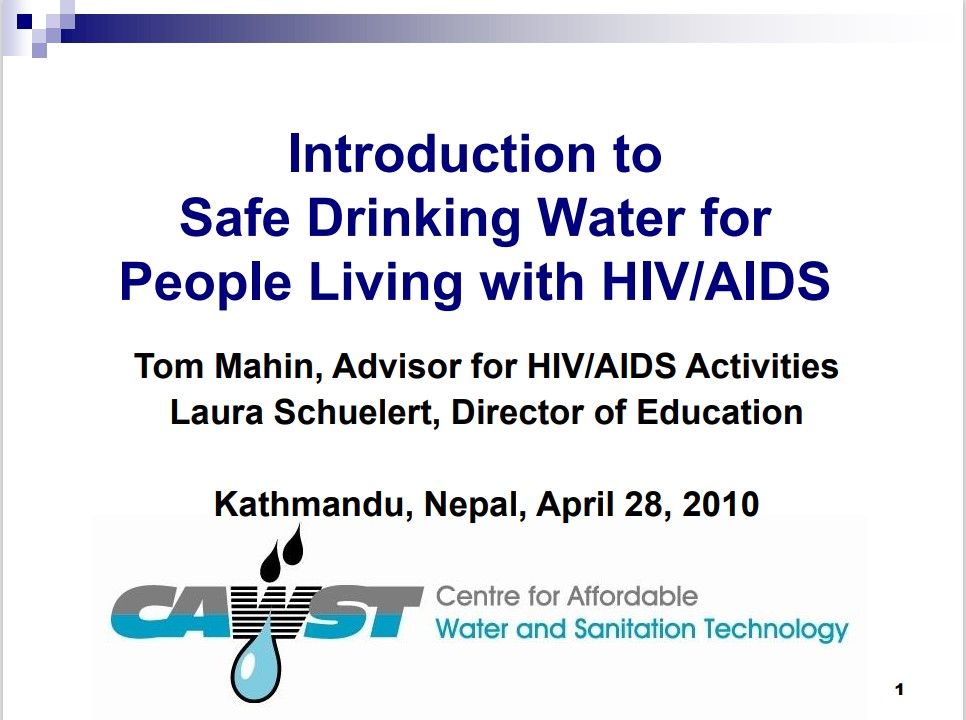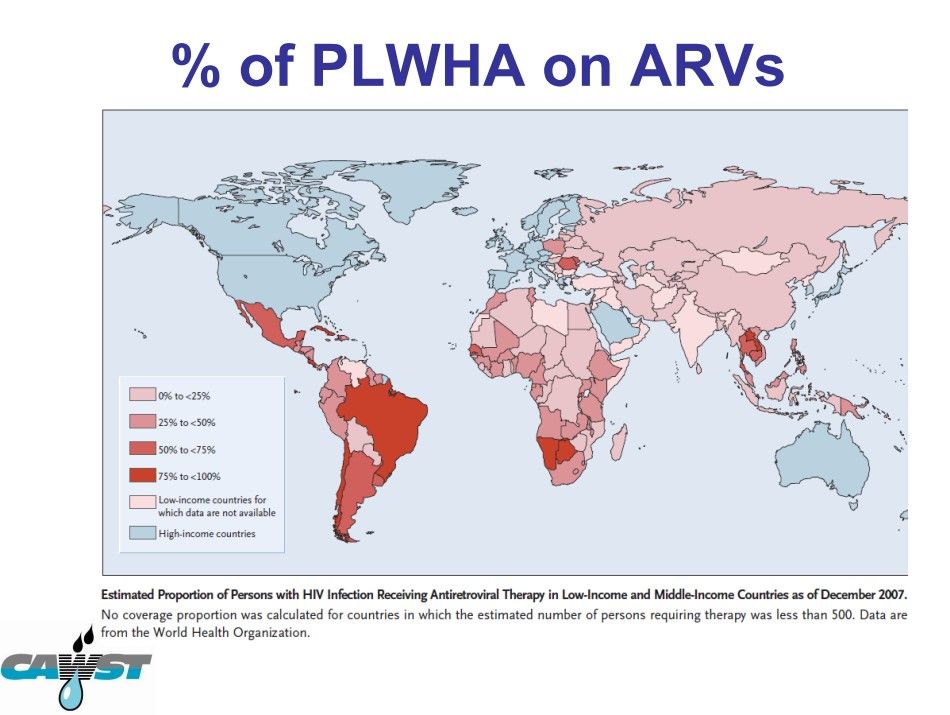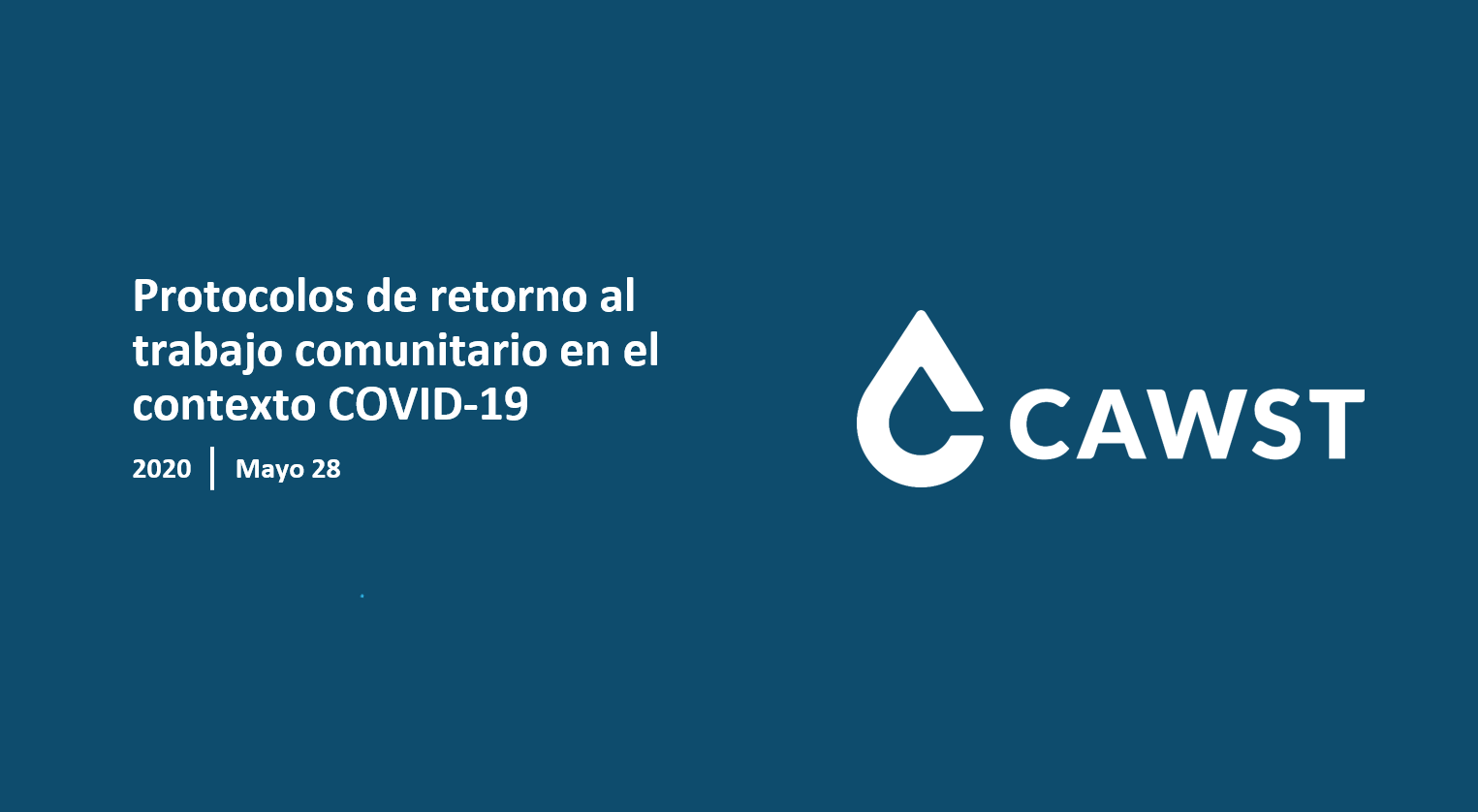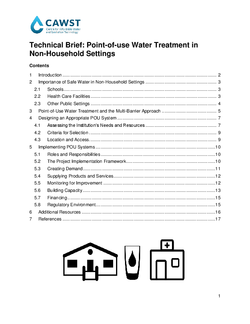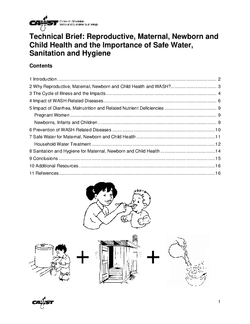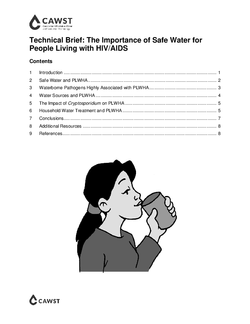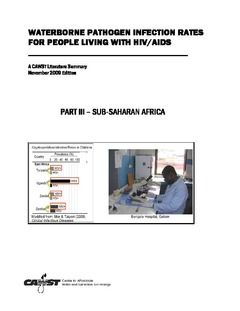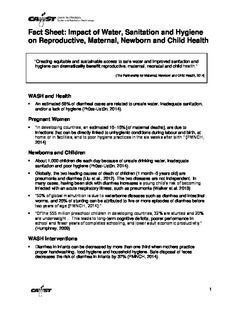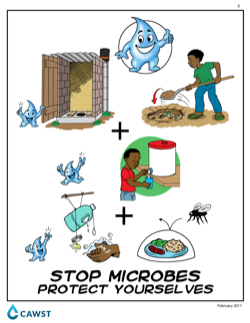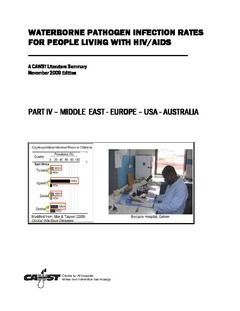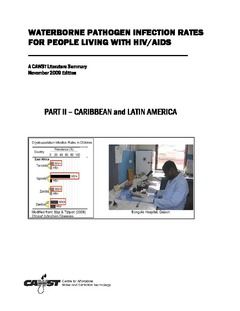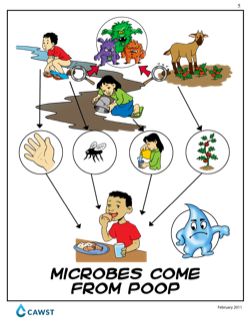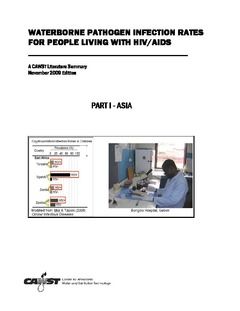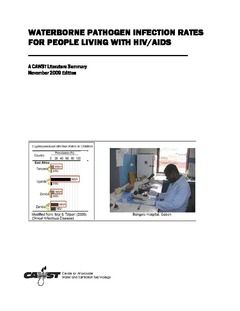Explore WASH and Health
Water-Related Disease Cards
These disease cards give an overview of the distribution, cause, symptoms, prevention, and treatment of common water-related diseases.
Languages
Spanish
English
French
Arabic
Contaminated Water Contains Microbes that Make Us Sick
Contaminated water can make us sick (diarrhea, vomiting, hospitalization, death).
Languages
English
Spanish
Haitian Creole
French
Swahili
Wayuu
Household Water Treatment and Safe Storage Workshop
This collection contains the resources for both trainers and participants for the Household Water Treatment and Safe Storage workshop. This two to three day workshop provides an introduction to drinking water quality, the Multi-Barrier Approach to safe drinking water, household water treatment and safe storage (HWTS) options, behaviour change, and implementation best practices. The intended participants are people responsible for making decisions about HWTS selection and implementation.
Languages
French
Spanish
English
Arabic
Hindi
Water-Related Disease Cards
These disease cards give an overview of the distribution, cause, symptoms, prevention, and treatment of common water-related diseases.
Languages
Spanish
English
French
Arabic
Chlorine Solution Calculator for Surface and Hand Disinfection
This spreadsheet is a calculator to prepare chlorine solutions using different product concentrations with Sodium Hypochlorite (bleach) or Calcium Hypochlorite (powder or granular chlorine) for surface and hand disinfection. There are other documents including one on how to use Sodium Hypochlorite (bleach) or Calcium Hypochlorite (powder or granular chlorine). This document was prepared in response to the COVID-19 pandemic.
Languages
English
COVID-19 Health Screening Questionnaire
This is a questionnaire to assess symptoms at a workplace and a temperature log to be used by every staff, volunteer, training participant, or other individual in the workplace during the COVID-19 pandemic. Please, remember to adapt this form to the privacy policies applicable to your context. Also see the Temperature Log.
Languages
English
COVID-19 Staff Temperature Log
This is a questionnaire to assess symptoms at a workplace and a temperature log to be used by every staff, volunteer, training participant, or other individual in the workplace during the COVID-19 pandemic. Please, remember to adapt this form to the privacy policies applicable to your context. Also see the Health Screening Questionnaire.
Languages
English
Preparing Chlorine Solutions using Calcium Hypochlorite Products for Surface and Hand Disinfection
This document contains instructions and safety measures to prepare chlorine solutions with Calcium Hypochlorite (powder or granular chlorine) for surface and hand disinfection. There are other documents including one on how to use Sodium Hypochlorite (bleach) as well as a Calculator (excel sheet) for different product concentrations. This was prepared to respond to the COVID-19 pandemic.
Languages
English
Preparing Chlorine Solutions using Sodium Hypochlorite for Surface and Hand Disinfection
This document contains instructions and safety measures to prepare chlorine solutions with Sodium Hypochlorite (bleach) for surface and hand disinfection. There are other documents including one on how to use Calcium Hypochlorite (powder or granular chlorine) as well as a Calculator (excel sheet) for different product concentrations. This was prepared to respond to the COVID-19 pandemic.
Languages
English
Making a Soap Solution for Handwashing Video
Use this video to make a handwashing soap solution from laundry detergent, if soap or hand sanitizer (handrub) are not easily available. This was created in response to the COVID-19 pandemic.
Languages
English
Instructions for Making a Soap Solution for Handwashing
Use these instructions to make a handwashing soap solution from laundry detergent, if soap or hand sanitizer (handrub) are not easily available. This was created in response to the COVID-19 pandemic.
Languages
English
How to Prepare Chlorine Solutions for Surface and Hand Disinfection
This lesson plan contains instructions to facilitate a session where participants will learn how to safely prepare chlorine solutions for surfaces and hand disinfection. This was prepared in response to the COVID-19 pandemic.
Languages
English
Workplace Safety during the COVID-19 Pandemic: Entry Screening
The goal of this guidance document is to help organizations to work as safely as possible and minimize the risk of COVID-19 transmission in the workplace. This is updated as of June 19, 2020.
Languages
English
WASH for Recovery (WASH-R Nepal) Workshop
This workshop is intended to support people who facilitate WASH awareness workshops. It is based on the practical experience of the Environment and Public Health Organization (ENPHO) and the Centre for Affordable Water and Sanitation Technology (CAWST). It has been developed specifically for the context of Nepal. The lessons are for WASH promoters and work well for participants with low levels of literacy. Each lesson comes with the materials needed or instructions on how to build the necessary materials.
Languages
English
Menstruation - Lesson Plan (MHM Nepal)
The focus of the lesson is to know experiences of first menstruation, become familiar with the term menstruation, myths and misconceptions related to menstruation. This helps students to talk confidently and accurately about menstruation.
Languages
English
Menstrual Cycle - Lesson Plan (MHM Nepal)
This lesson focuses on the general idea about female reproductive organs and the menstrual cycle.
Languages
English
Presentation: Importance of WASH for Maternal and Child Health (MNCH) - Online training
This presentation was used to deliver a webinar that synthesizes the most recent research, to discuss the impact of WASH related diseases on pregnant and breastfeeding mothers, and children under the age of five. We will describe how diarrheal disease leads to malnutrition and other related nutrient deficiencies in mothers and children. Finally, we will discuss potential WASH interventions to improve the health of mothers and children.
Languages
English
HWT for Vulnerable Populations Presentation (PLWHA)
This presentation describes the importance of safe water for vulnerable populations
Languages
English
French
Spanish
Waterborne Pathogens Presentation (PLWHA)
This presentation describes the risk of waterborne pathogens for people living with HIV/AIDS
Languages
English
People Living with HIV/AIDS 1 Day Workshop Agenda Option 2
This is a 1 day seminar focusing on the challenges of living with HIV/AIDS and how household water treatment can help
Languages
English
French
Spanish
Mahin Fuller Presentation (PLWHA)
This presentation describes the importance of safe water for people living with HIV/AIDS
Languages
English
People Living with HIV/AIDS 1 Day Workshop Agenda Option 1
This is a 1 day seminar focusing on the challenges of living with HIV/AIDS and how household water treatment can help
Languages
English
French
Spanish
HWT Presentation (PLWHA)
This presentation describes how HWTS can provide safe water for people living with HIV/AIDS
Languages
English
People Living with HIV/AIDS 1 Day Workshop Agenda Option 3
This is a 1 day seminar that focuses on identifying the challenges of living with HIV/AIDS and brainstorming local solutions
Languages
Spanish
English
French
Reproductive, Maternal, Newborn and Child Health Resources
This collection contains the resources of both trainers and participants for the Reproductive, Maternal, Newborn and Child Health workshop. This half day to one day workshop is designed for WASH, community development and health organizations. The workshop explores the impact of WASH-related diseases on pregnant women, newborns and children; WASH interventions to address these impacts; a multi-barrier approach to provide safe drinking water; and effectiveness of different household water treatment and safe storage (HWTS) options for pathogens of concern for pregnant women, newborns and children.
Languages
English
Spanish
French
Safe Water for People Living with HIV/AIDS Workshop
This collection contains the resources for both trainers and participants for the Safe Water for People Living with HIV/AIDS workshop. This one day workshop is designed for organizations working in WASH and with people living with HIV/AIDS. The workshop reviews waterborne pathogens highly associated with PLWHA as well as household water treatment solutions.
Languages
English
French
Spanish
Diarrheal Disease Response - Lesson Plan (WASH-R Nepal)
The focus of this lesson is to explore different diarrheal diseases present within communities and to identify ways of responding to them. Participants will discuss effective measures for responding to the presence of diarrheal disease and demonstrate how to effectively prepare oral rehydration solution in an emergency response context.
Languages
English
COVID-19 Health and Safety Protocols Adapted for Honduras
This PowerPoint includes practical recommendations on safety and security when doing community work adapted for different contexts. Este PowerPoint contiene una serie de recomendaciones de bioseguridad para la vuelta al trabajo en el contexto COVID-19 específicos y adaptados para Colombia.
Languages
Spanish
Water-Related Disease Card: Hepatitis A and E
This water-related disease card gives an overview of the distribution, cause, symptoms, prevention, and treatment of hepatitis A and E.
Languages
Spanish
French
English
Water-Related Disease Card: Typhoid Fever
This water-related disease card gives an overview of the distribution, cause, symptoms, prevention, and treatment of typhoid fever.
Languages
Spanish
English
French
Water-Related Disease Card: Fluorosis
This water-related disease card gives an overview of the distribution, cause, symptoms, prevention, and treatment of fluorosis.
Languages
French
Spanish
English
Water-Related Disease Card: Shigellosis
This water-related disease card gives an overview of the distribution, cause, symptoms, prevention, and treatment of shigellosis.
Languages
Spanish
French
English
Water-Related Disease Card: Rotavirus
This water-related disease card gives an overview of the distribution, cause, symptoms, prevention, and treatment of rotavirus.
Languages
English
Spanish
French
Water-Related Disease Card: Cholera
This water-related disease card gives an overview of the distribution, cause, symptoms, prevention, and treatment of cholera.
Languages
English
Spanish
French
Water-Related Disease Card: Giardiasis
This water-related disease card gives an overview of the distribution, cause, symptoms, prevention, and treatment of giardiasis.
Languages
English
Spanish
French
Water-Related Disease Card: Ascariasis
This water-related disease card gives an overview of the distribution, cause, symptoms, prevention, and treatment of ascariasis.
Languages
English
Spanish
French
Water-Related Disease Card: ETEC
This water-related disease card gives an overview of the distribution, cause, symptoms, prevention, and treatment of Enterotoxigenic E. coli (ETEC).
Languages
Spanish
French
English
Water-Related Disease Card: Arsenicosis
This water-related disease card gives an overview of the distribution, cause, symptoms, prevention, and treatment of arsenicosis.
Languages
French
Spanish
English
Water-Related Disease Card: Schistosomiasis
This water-related disease card gives an overview of the distribution, cause, symptoms, prevention, and treatment of schistosomiasis.
Languages
English
Spanish
French
Water-Related Disease Card: Cryptosporidium
This water-related disease card gives an overview of the distribution, cause, symptoms, prevention, and treatment of cryptosporidium.
Languages
English
French
Spanish
Drinking Water Sources Presentation (PLWHA)
This presentation describes the water sources that are of greatest risk to people living with HIV/AIDS
Languages
English
Safe Water and HIV Presentation (PLWHA)
This presentation describes the importance of safe water for people living with HIV
Languages
English
Safe Water for PLWHA Presentation (PLWHA)
This presentation describes the effects of unsafe water for people living with HIV/AIDS
Languages
French
Spanish
English
COVID-19 Health and Safety Protocols Adapted for Colombia
This PowerPoint includes practical recommendations on safety and security when doing community work adapted for different contexts. Este PowerPoint contiene una serie de recomendaciones de bioseguridad para la vuelta al trabajo en el contexto COVID-19 específicos y adaptados para Colombia.
Languages
Spanish
Point-of-Use Water Treatment for Non-Household Settings
This Technical Brief introduces the importance of point-of-use (POU) water treatment in non-household settings. These institutions include schools, health care facilities, workplaces, temporary use settings (e.g., restaurants, markets, places of worship, public facilities), mass gatherings (e.g., public events, festivals), and dislocated populations (e.g., refugee camps, prisons).
Languages
Spanish
English
French
Reproductive, Maternal, Newborn and Child Health and the Importance of WASH Technical Brief
This technical brief introduces the overall impact of poor WASH on RMNCH, discusses nutrient deficiencies, and identifies ways to prevent WASH-related diseases.
Languages
Spanish
English
French
Importance of Safe Water for People Living with HIV / AIDS
This technical brief is for people who are interested in knowing more about the importance of safe water for people living with HIV / AIDS (PLWHA).
Languages
Spanish
English
French
WASH Diseases in People Living with HIV / AIDS - Sub-Saharan Africa
This document summarizes published studies from countries in Sub-Saharan Africa about WASH related diseases of concern for people living with HIV / AIDS (PLWHA) in the region.
Languages
English
Impact of WASH on Reproductive, Maternal, Newborn and Child Health Fact Sheet
This fact sheet summarizes important facts about the impact of poor water, sanitation and hygiene on reproductive, maternal, newborn and child health.
Languages
English
French
Spanish
Impacts of WASH on Reproductive, Maternal, Newborn and Child Health Literature Summary
This document summarizes published studies and information about the impact of water, sanitation and hygiene on reproductive, maternal, newborn and child health.
Languages
English
Introduction to Household Water Treatment for Vulnerable Populations (MNCH)
This presentation describes the importance of safe water for vulnerable populations
Languages
French
English
Spanish
Stop Microbes Protect Yourselves
There are three main ways to stop the transfer of faeces to our mouths: basic sanitation, safe water and proper hygiene.
Languages
Haitian Creole
English
Swahili
Spanish
French
WASH Diseases in People Living with HIV / AIDS - Middle East
This document summarizes published studies from countries in the Middle East, Europe and USA about WASH related diseases of concern for people living with HIV / AIDS (PLWHA) in the region.
Languages
English
Reproductive, Maternal, Newborn and Child Health and WASH-Related Diseases Technical Brief
This technical brief introduces WASH-related diseases of concern for reproductive, maternal, newborn and child health (RMNCH). It also discusses the impacts of these diseases on RMNCH.
Languages
Spanish
French
English
Importance of WASH for the Health of Mothers and Children (MNCH)
This presentation describes the effects of unsafe water for mothers and children
Languages
English
Spanish
French
WASH Diseases in People Living with HIV / AIDS - Latin American, Caribbean
This document summarizes published studies from countries in Latin America and the Caribbean about WASH related diseases of concern for people living with HIV / AIDS (PLWHA) in the region.
Languages
English
Microbes Come from Poop
Microbes are transferred from faeces to our mouths in many ways (hands, flies, water, fields, food).
Languages
Haitian Creole
Swahili
French
English
Spanish
Introduction to Safe Water for People Living with HIV/AIDS (MNCH)
This presentation describes the effects of unsafe water for people living with HIV/AIDS
Languages
Spanish
French
English
Maternal and Child Health - Key Connections with HWTS (RMNCH)
This presentation is used as a guide to discuss diseases of concern to pregnant women, newborns and children and analyze the effectiveness of different HWTS options for maternal, newborn and child health.
Languages
Spanish
French
English
Reproductive, Maternal, Newborn and Child Health Lesson Plans
These are CAWST lesson plans on maternal and child health and how it is related to WASH.
Languages
French
English
Spanish
WASH Diseases in People Living with HIV / AIDS - Asia
This document summarizes published studies from countries in Asia about WASH related diseases of concern for people living with HIV / AIDS (PLWHA) in the region.
Languages
English
Maternal and Child Health - Disease Information Packages (RMNCH)
This presentation is provided as a tool for participants to analyze the impact of some WASH-related diseases on reproductive, maternal, newborn and child health.
Languages
Spanish
English
French
People Living with HIV/AIDS Lesson Plans
These are CAWST's lesson plans that focus on WASH and its impact on the health of people living with HIV/AIDS
Languages
English
Spanish
French
Water, Sanitation and Hygiene Poster Set
This poster set includes water, sanitation and hygiene (WASH) posters to teach about good WASH practices, including household water treatment technologies.
Languages
English
Khmer
Swahili
French
Haitian Creole
Spanish
Wayuu
WASH Diseases in People Living with HIV / AIDS Literature Summary
This document summarizes published studies and information about WASH related diseases of concern for people living with HIV / AIDS (PLWHA).
Languages
English
Reproductive, Maternal, Newborn and Child Health and WASH Workshop Outline
This workshop outline contains a workshop description, objectives, audience, content and training materials needed for this workshop. This is a 1/2 - 1 day seminar about the link between reproductive, maternal, newborn and child health and WASH.
Languages
English
Spanish
French
About CAWST
CAWST is a Canadian charity and licensed engineering firm. We address the global need for safe drinking water and sanitation by building local knowledge and skills on household solutions people can implement themselves.
